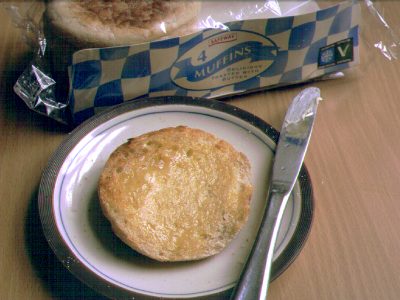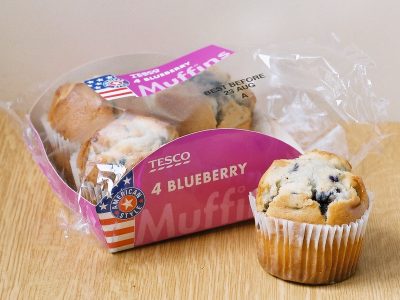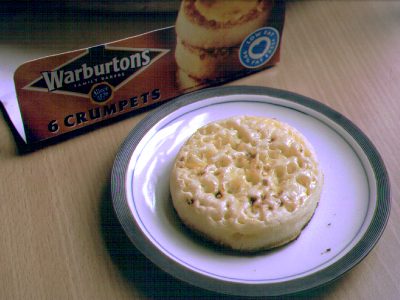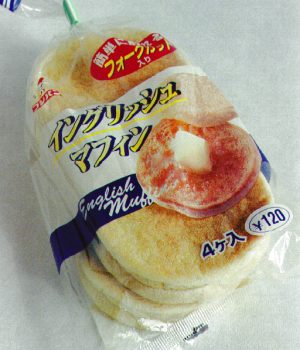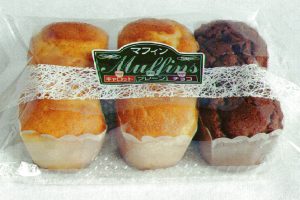The Great Muffin Mystery
| Have you seen the muffin man, the muffin man, the muffin man?
Have you seen the muffin man, that lives in Drury Lane? |
I grew up in England (Gloucestershire) in the 1950s, and of course I learnt the nursery song - yet I'm sure I had no very clear idea what a "muffin" was. Somehow or other, I was lead to believe it rather like a crumpet (which was very familiar), yet definitely different. Over quite a few years of living in different parts of Britain (West Country, London, and Manchester) I began to realise quite how localised bakery terms are - the first shock came one day in London when I was visited by a sudden craving for a lardy. Half aware that I couldn't actually remember seeing any in our local bakery, I asked "Have you any lardies?" The response suggested they thought I might be from Mars (or Texas, or somewhere like that).
|
|
So during our trip to England this year (2000), I did some research. It's certainly easy to find the word, and my impression was that the most prominent use is in American-style fast-food outlets, for the sweet bun type. A few anecdotal enquiries suggested, though, that many people are aware there are two types, and the supermarkets soon produced some samples, as in the photos. The flat type are just called "muffins", while the sweet bun type usually attract some sort of "American style" label. It seems entirely possible that the original of the sweet bun type still exists in some part or parts of England, but I wasn't able to find it.
For reference, I got some crumpets as well. They are certainly more distinctive than "flat" muffins, particularly in their soft, rather rubbery, consistency. They are made from a batter, and in the cooking process bubbles (I suppose of carbon dioxide, since they include yeast) make these curious vertical "pores". It's also interesting that I remember my grandfather usually called crumpets "pikelets", and I was amazed to find pikelets in the supermarket too: strictly they appear to be a much thinner version of a crumpet. (Oh, and I ought to remind non-native speakers of British that "crumpet" has an extra, vulgar meaning, a non-count noun, as in "a bit of crumpet", meaning a sexually available woman.)
The Shorter Oxford English Dictionary (1933) has an interesting entry:
"A light, flat, circular, spongy cake, eaten toasted and buttered at breakfast or tea. Formerly (now [dialect]) applied to other kinds of tea-cake."
This seems to imply that the deep sweet type had become a minority animal (perhaps since its transfer to America).
Webidence is not so easy to collect, because most of it is text, and it's not always obvious which sort of muffin is referred to. But the impression that current popularity of the sweet type is an American import is supported by the high frequency of blueberry - that archetypally American of fruits - as a flavouring. Here's a typical example, in a description of a brasserie chain (Brazz) in the West Country:
"A graze menu, for those with time only to munch at the bar, runs to blueberry muffins, pickled quails' eggs or a club sandwich terrine."
Meanwhile, The (UK) Federation of Bakers gives the following description, explicitly describing "American sweet muffins" as a "newer product".
Rolls and Morning GoodsMorning goods are traditionally sold in the morning for consumption on the day they are baked. Modern technology, ingredients and packaging have improved the keeping quality of these products and now they can be purchased for consumption at any time of the day, or the next!
Some traditional British products include: rolls and baps, toasting products such as muffins, crumpets and pikelets, scones, teacakes, buns and other fruited products, hot plate products such as pancakes and griddle scones, waffles and potato cakes and not forgetting seasonal products such as hot cross buns.
Newer products include croissants, brioches, pain au chocolat (literally bread with chocolate!), bagels, American sweet muffins and other semi-sweet bread products.
Japan update
|
|
